The Able Tasman Coast Track
By Jen.
We had some friends who had planned to come visit us in New Zealand while we were there. It was mostly an excuse to do a trip they had always wanted to do, but it was great to see them again. We decided to join them on their Abel Tasman Coast Track walk for 4 days and 3 nights. This track is the most popular Great Walk in NZ. Because of some mixups with their campervan rental, they arrived a day later than planned in Nelson, but they were still able to make it on time to do the walk. As we were doing last-minute packing before the walk, Jonathan measured everyone’s backpacks. Jonathan and I had the lightest; with mine a full 10 pounds lighter than everyone else! Fortunately, because of availability, the first 2 days were only about 4-6 km each, so they could take time to lighten their packs (much of the weight was the extra liquids they brought along).
 4 Days of Food with 1 day of spares and snacks.
4 Days of Food with 1 day of spares and snacks.
They had arranged a lovely water taxi ride to the far end of the track, after which we would walk back to the beginning, a total of 38 km. Sadly, after 10 minutes of being on the water taxi, we realized that I had forgotten my SD card for my camera and would be stuck taking pictures only with my phone for the next 4 days.


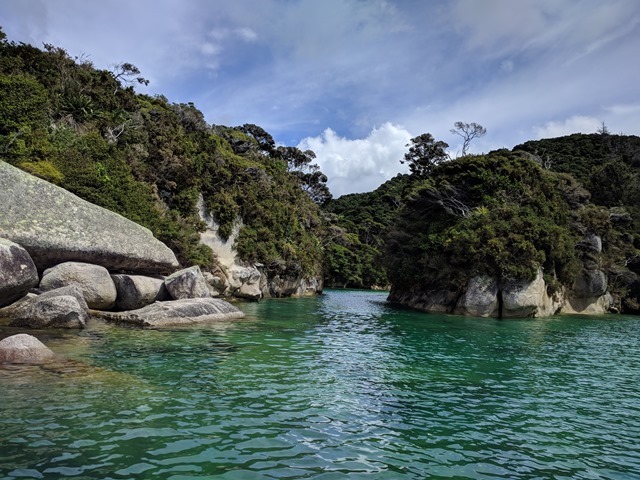

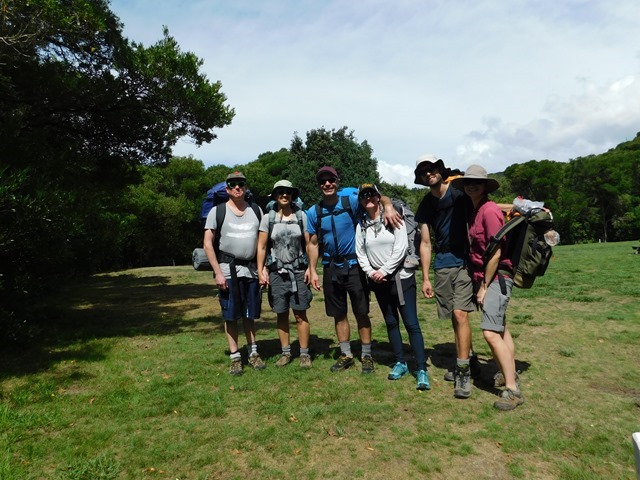 Start of the walk when we are bright-eyed and bushy-tailed.
Start of the walk when we are bright-eyed and bushy-tailed.
At the end of Day 1 when I was walking back from brushing my teeth, I thought I heard a weka in bushes, but then I saw something jump into the tree. I was really confused as wekas generally prefer the ground. Upon closer investigation, I saw a furry tail!
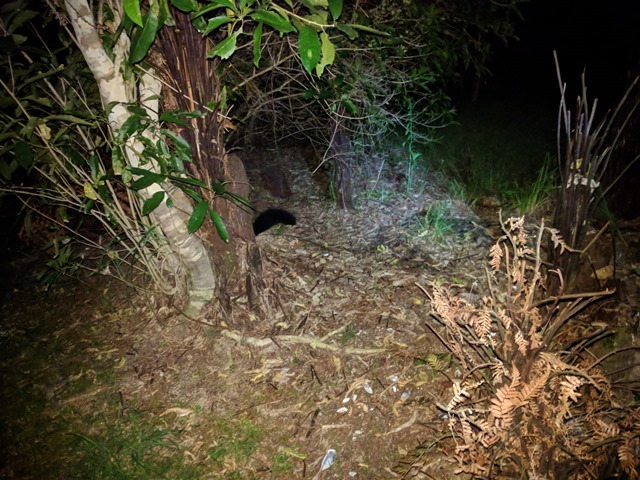 See the tail?
See the tail?
 It was a brush-tailed possum! They are introduced here, and are considered a pest, killing many of the native birds.
It was a brush-tailed possum! They are introduced here, and are considered a pest, killing many of the native birds.
Day 2 started early in the morning, when Jonathan realized there was a puddle INSIDE the tent by his feet. Upon further investigation, we discovered that at some point our under-tent tarp (footprint) that keeps us dry and moved out from under the tent on the uphill side. The rain that started in the night made a nice stream from that exposed section and funneled it under the tent directly under Jonathan’s sleeping pad. Fortunately, most things were in waterproof bags, so we just moved things out of the path and went back to sleep for a few hours. Unfortunately, that made us a bit slow in the morning, so we were rushing to get to the tidal flats that must be crossed only within 1-2 hours before and after low tide. Some of the people we passed said the water was already getting high and that we might not make it in time. But, when we got there, we discovered we had been concerned over nothing. The flats were still void of tide, it was only the streams that had any water in them. The rain continued most of the day, making it dreary to walk in it. But, it was another short day.
 Crossing tidal flats on Day 2.
Crossing tidal flats on Day 2.
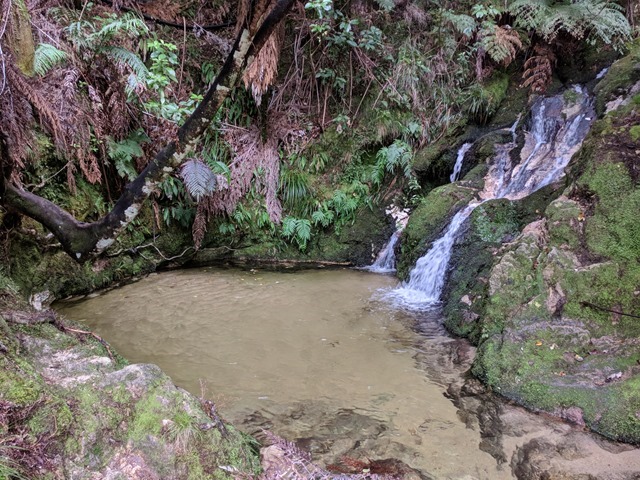 Onetahuti Pool at the campground on Day 2.
Onetahuti Pool at the campground on Day 2.
 A cave at that campground as well. It also sported some glow worms that we could show off to our guests.
A cave at that campground as well. It also sported some glow worms that we could show off to our guests.
 Crossing tidal flats/river on Day 3.
Crossing tidal flats/river on Day 3.
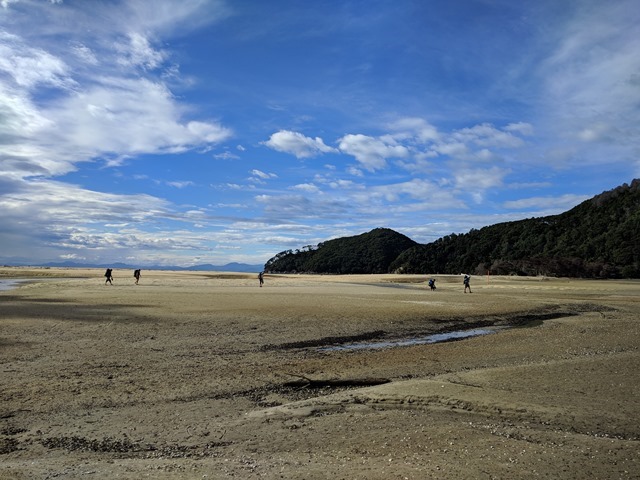
Day 3 was the longest day, reaching 20+ km. After doing a detour for Cleopatra’s pools, the track split (the first of 6 for the rest of the day). One part of the group wanted to take the shortest route (up and over a mountain), while the other wanted to take the easier route. Majority vote said to take the shorter route, but when I started up, my knee started acting up, so I told them I needed to go the other route. My buddy joined me, while Jonathan and the others continued up the shorter route. Separated from the others and believing our route to be the better choice, we were determined to beat them to the camp. It didn’t take long for us to realize that I had no water (Jonathan carries ours) and the other group had no map.
https://www.blogger.com/null Cleopatra’s Pool.
https://www.blogger.com/null
Cleopatra’s Pool.
https://www.blogger.com/null
Swiftly walking, we came to the intersection of our two paths. We took a moment to investigate whether we could see any fresh tracks, but didn’t see any and thought we had definitely beat them, so we barreled on. Interestingly, none of the signs mentioned our campground. On the last track division, we had to make a best guess, and following the map, guessed heading right (south). After a while, we began to wonder if we had made the wrong choice. Following the map, I thought we would come across it around the next bend, but we ran into an older couple walking from the other direction and thought we would ask them if they had seen the signs for it. Sure enough, they had and as we were finishing off our conversation with them, I heard Jonathan’s voice. Instinctively, I turned to Erika and said, “That’s them! Run!” and we took flight, leaving the couple wondering what in the world was going on. Energized, we ran like we hadn’t been walking 19 km already that day and giggled along the way. As we ran, I realized the ridiculousness of running, but we decided we really wanted to beat them down to the campsite and act like we had been there forever already! Sensing we had gotten far enough in front, we slowed to a walk and came to our turnoff. As continued on down, I heard Jonathan again so we quickened our pace again. At the bottom, we quickly chose a picnic table and switched to our swimsuits. Strangely, they hadn’t caught up to us yet, so we decided to go for a swim.
 One of the views on our easier path.
One of the views on our easier path.
We finished our swim and rinsed off, but still no one else had joined us. Very confusing! I thought perhaps they might be waiting at the turnoff for the campground, since twice that day we had mentioned waiting at junctions, even though we had been clear we would meet at the campground. For my peace of mind, I left my friend to watch the stuff (told her I would be back in 15 min, but ended up taking 30min) and ran up to the top of steep track to the turnoff. Upon reaching the top, I saw none of our crew there, so I set up some markers and wrote a note in the dirt. There was someone there taking a breather and heading towards the way we had come, so I was asking her that if she saw a group of 4 Americans to tell them we had gone on to the campground. As she was leaving, we heard some people up the track and it was them! Turns out they had turned left where we had turned right at the last junction and spent a while trying to find the campsite and I had mistaken someone else’s voice for Jonathan’s. After one guy had ran ahead and Jonathan had walked up a hill to get reception, they discovered where they had made the wrong turn and corrected themselves (annoyingly only 700 m away, but had to backtrack upon the track for several kilometers). Now we will never know whose route was better! We do know that they ended up walking 3 km more than we did, haha!
 Everyone back safe and sound after a long day.
Everyone back safe and sound after a long day.
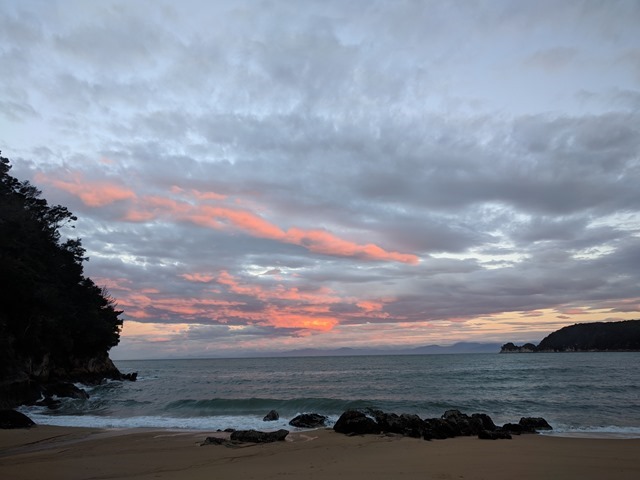
The rest of walk finished uneventfully and we enjoyed a cooked meal at the trailhead as well as tasty Indian food for dinner with some lovely hosts in Nelson. The company we had made the walk great, but we did learn that we don’t feel too bad about skipping most of the great walks. The walks are nice and comparatively easy, but aren’t any more scenic than what we have been able to experience on other walks in NZ.
 Sunrise on Day 4.
Sunrise on Day 4.
 Parent and baby weka!
Parent and baby weka!
 FWIW I've also found hand held radios to be worth their weight in gold quite a few times.
FWIW I've also found hand held radios to be worth their weight in gold quite a few times.